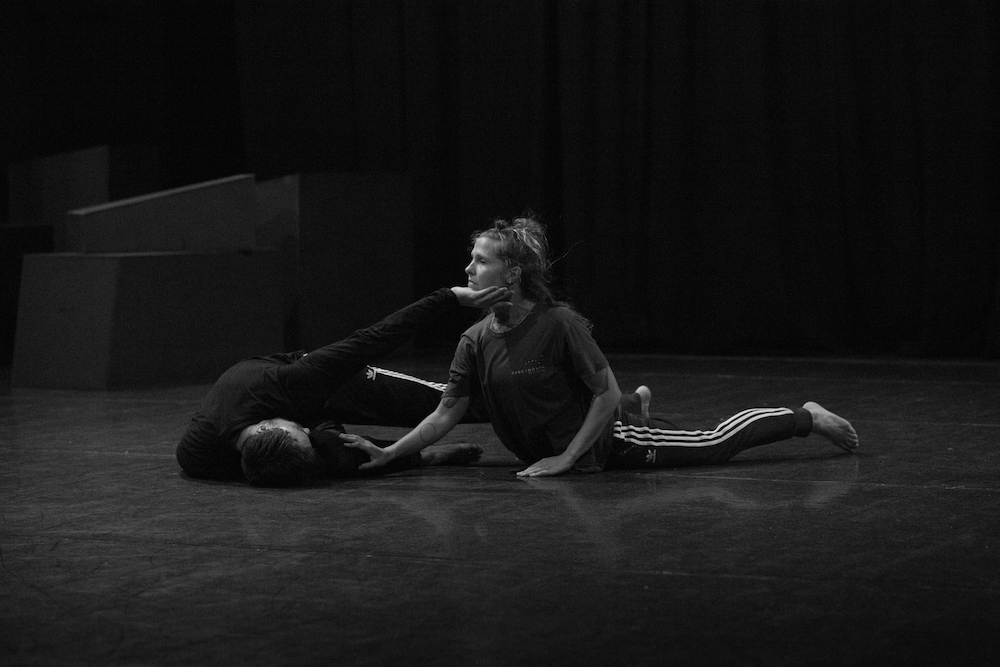Brisbane Powerhouse, Powerhouse Theatre
September 22, 2018
An unyielding, wedge-shaped wall cuts through the centre of the stage at Brisbane’s Powerhouse Theatre, dividing it neatly in two and obscuring areas of the space from all but the centremost members of the audience. Townsville-based contemporary dance company Dancenorth’s new work Dust is directed and choreographed by the company’s Artistic Director Kyle Page and Associate Artistic Director Amber Haines, and follows the success of Lucy Guerin’s award-winning Attractor, which the company premiered in 2017 in Melbourne before touring, including to last year’s Brisbane Festival.
Dust explores ideas of inheritance in the wake of the birth of the directors’ son Jasper last year: “What has been handed to you, what has been handed to us, and what in turn we hand on to other, our children,” Page and Haynes write in their Directors’ Note. Thanks to a deceptively minimal set by Liminal Studio, the audience is keenly aware of who has been handed what even before the lights go down at the start of the performance: those in centre seats can take in the entire vista, while those on either edge will only see half of the opening scene when the seven dancers (in gauzey, robe-like costumes by Harriet Oxley) take to the stage.
 Dancers Jack Ziesing and Jenni Large in rehearsal for Dancenorth’s Dust. Photo © Amber Haines
Dancers Jack Ziesing and Jenni Large in rehearsal for Dancenorth’s Dust. Photo © Amber Haines
A single dancer lies prone on the left side of the stage, while on the right an ensemble huddles together in ritualistic closeness. Composer and violinist Jessica Moss – who performs from the side of the stage – and composer and sound designer Alisdair Macindoe, provide a gently textural drone. The relationships (both toxic and collaborative) between individuals and communities have been in the spotlight during this segment of the Brisbane Festival, which has seen the world premiere of Circa’s ecstatic En Masse and a semi-staged production of Benjamin Britten’s bleak opera Peter Grimes. Dust explores similar concerns, with the lone dancer’s gentle, lyrical movements becoming more urgent as she struggles to connect with the dancers on the other side of the wall, who in turn are attempting to break through from their end. Movement suggestive of digging, clawing and striking are rendered here in a dream-like haziness. When the group of dancers begins to press against and spin the wall, a single dancer slips through to the other side, for a tentative, then increasingly passionate duet. But as a sheet slips off the wall it’s revealed to be constructed from a series of modular blocks that fit together, and are now removed one by one, changing the game completely.
The work emerges in a series of episodes centred around the blocks as variously objects of value (from the catharsis of the wall’s deconstruction, we realise one group has accumulated most of the blocks, while a single dancer guards a smaller pile) and stage architecture (a long ramp, a castle-like structure) the choreography suggesting elements of shifting social and spiritual ritual or confrontation. The work of moving and arranging blocks is done with reverence, accompanied always by one or several dancers in writhing, organic choreography, while more personal interactions range from touching to violent. Rain-like effects in the sound subtly increase the emotional pull of community and shelter, while Niklas Pajanti’s soft lighting is a perfect complement to set and costumes.
Dust is a beguiling and intriguing work, but it does feel over long – the unspooling mystery of disassembly and reassembly eventually becoming laborious rather than charming, an endless vision of lifting and carrying – and some of the images are on the obvious side (an individual butts heads with a group, a literal wedge is driven between a pair of lovers). The intense focus of the dancers, however, is immaculate, creating a deeply immersive atmosphere, and all in all it’s a pleasure to watch this work of delicate beauty unfold.











Comments
Log in to join the conversation.